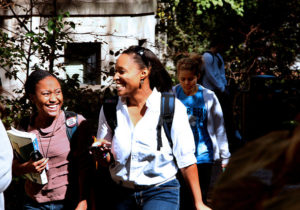Learning from HBCUs: How to Produce Black Professionals in STEMM
It is not uncommon for individuals to be shocked when they learn that one in six African Americans who receive a bachelor’s degree has graduated from a historically black college and university (HBCU). Despite existing for more than 175 years and having alumni including U.S. Vice President Kamala Harris, HBCUs still face issues in securing funding. Established before the Civil Rights Act of 1964 with the main intention of educating African Americans, many HBCUs have recently closed due to a lack of financial support (Shuler, H. et.al., 2022). Together with my colleagues, I wanted to highlight why HBCUs are still an important pillar of higher education in the United States and provide suggestions for giving HBCUs the support they need and deserve to thrive as educational enterprises for the African American diaspora.
Our article covers some of the of forgotten history of HBCUs. Importantly, HBCUs are incredibly successful in producing high quality professionals. African Americans who enroll at HBCUs are more successful in completing their degrees within four years than at other higher education institutions. Beyond this, HBCUs teach lessons that predominantly white institutions (PWIs) can learn from. The students at HBCUs exemplify higher happiness attainment and a greater sense of belonging, which culminates in an environment that produces more confident individuals. This, in combination with instilling self-worth in their students, are lessons that other institutions can adopt and implement at their organizations (Ginsberg et al., 2015). For many minorities, it can remain difficult task to gain a strong sense of self and not be mistreated at other institutions. HBCUs can serve as a critical junction to work with leadership at PWIs to establish these alternative attitudes to bolster and support underrepresented minorities at all institutions.
However, HBCUs are not receiving the financial support they need. Part of this stems from the differential rate of graduation and employment rates. While HBCUs are producing qualified individuals, their post-graduation employment rates still lag behind graduates of PWIs. This could be because a lack of funding: Public universities as a whole spend an average of $25,000 per student, compared with only $7,000 for public HBCUs (Weissman, 2021). Furthermore, while the US News and World Report is not a definitive ranking, many HBCUs are lower ranked than PWIs. Indeed, this could arise due to only 13 of the more than 100 HBCUs having an endowment higher than the median national endowment.
While this article raises the problems that may be holding back HBCUs or forcing some to close, I believe in the future it is more critical to focus on the solutions. For example, PWIs can utilize ideas from HBCUs to patch the leaky pipeline (Hinton Jr et al., 2020) and reduce the number of remarkable individuals who are discouraged from pursuing a career in STEMM. New collaborations between PWIs with large endowments and HBCUs can prove mutually beneficial. Some solutions, such as those proposed in the recent federal “Build Back Better” plan, recognize the importance of HBCUs, but they do not offer HBCUs the support they need. However, now remains a critical junction in which PWIs can support HBCUs and build long-lasting relationships to improve each other and the landscape of higher education as a whole.
References:
Ginsberg, A., Gasman, M., Samayoa, A., & Ramos, F. (2015). Re-Assessing Teacher Education Quality: What NCTQ Isn’t Telling Us About the Impact and Value of HBCUs. Teachers College Record.
Hinton Jr, A. O., Termini, C. M., Spencer, E. C., Rutaganira, F. U., Chery, D., Roby, R., Vue, Z., Pack, A. D., Brady, L. J., & Garza-Lopez, E. (2020). Patching the leaks: Revitalizing and reimagining the STEM pipeline. Cell, 183(3), 568–575.
Shuler, H. D., Spencer, E. C., Davis, J. S., Damo, S., Shakespeare, T. I., Murray, S. A., Lee, D. L., & Hinton, A., Jr (2022). Learning from HBCUs: How to produce Black professionals in STEMM. Cell, 185(16), 2841–2845. https://doi.org/10.1016/j.cell.2022.06.013
Weissman, S. (2021, September 15). Report: Funding Gaps for HBCUs. Inside Higher Ed. https://www.insidehighered.com/quicktakes/2021/09/15/report-funding-gaps-hbcus






2 Comments